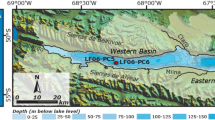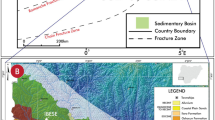Abstract
The Kaoping (Taiwan) and Kapuas (Indonesia) Rivers differ in hydrological cycle, topography and landscape. These differences strengthen the use of 14C dating, lignin-derived phenols, δ13C values and C/N ratios to determine the sources and diagenesis of surface sedimentary organic carbon (OC) in both rivers. The Kapuas River is surrounded by forest, resulting in sedimentary OC with a 14C age between 600 and 740 years, Λ (total lignin expressed as mg/100 mg OC) values from 0.94 to 3.70, δ13C values from −27.87 to −30.00‰, C/N ratios from 6.7 to 30.8, %OC from 0.63 to 9.24% and vanillic acid to vanillin ratio, (Ad/Al)v, values from 0.73 to 2.09, all of which indicate the presence of recent plant-derived organic matter. The tributaries and three locations upstream of the Kaoping River are also surrounded by forests, resulting in Λ values (0.51–4.80), δ13C values (−23.85 to −27.08‰), C/N ratios (14.1–28.7), %OC (1.01–7.86%) and (Ad/Al)v values (0.86–1.88), which are indicative of a terrestrial signal. No lignin oxidation products were detected in the mainstream of the Kaoping River or its coastal zone, hence the surface sediments OC with a 14C age between 4,915 and 15,870 years, enriched δ13C values (−23.30 and −26.54‰), lower C/N ratios (6.0–17.5) and lower %OC (0.15–2.24%) likely represent old rock and soil material. Massive floods during typhoons most probably cause plant materials from the Kaoping River and its coastal zone to be transported into the deep sea.




Similar content being viewed by others
References
Alin SR, Aalto R, Goñi MA, Richey JE, Dietrich WE (2008) Biogeochemical characterization of carbon sources in the Strickland and Fly rivers, Papua New Guinea. J Geophys Res 113:F01S05. doi:10.1029/2006JF000625
Bianchi TS, Argyrou M, Chippett HF (1999) Contribution of vascular-plant carbon to surface sediments across the coastal margin of Cyprus (eastern Mediterranean). Org Geochem 30:287–297
Bianchi TS, Galler JJ, Allison MA (2007) Hydrodynamic sorting and transport of terrestrially derived organic carbon in sediments of the Mississippi and Atchafalaya Rivers. Estuar Coast Shelf Sci 73:211–222
Braithwaite A, Smith FJ (1965) Chromatographic methods. Chapman and Hall, New York
Cerling TE, Wang Y, Quade J (1993) Expansion of C4 ecosystems as an indicator of global ecological change in the late Miocene. Nature 361:344–345
Chen C-TA, Liu JT, Tsuang B-J (2004) Island-based catchment—The Taiwan example. Reg Environ Change 4:39–48
Chiang C-S, Yu H-S (2006) Evidence of hyperpycnal flows at the head of the meandering Kaoping Canyon off SW Taiwan. Geo-Mar Lett. doi:10.1007/s00367-007-0098-7
Cowie GL, Calvert SE, Pedersen TF, Schulz H, von Rad U (1999) Organic content and preservational controls in surficial shelf and slope sediments from the Arabian Sea (Pakistan margin). Mar Geol 161:23–38
Dadson SJ, Hovius N, Chen H, Dade WB, Hsieh M-L, Willett SD, Hu J-C, Horng M-J, Chen M-C, Stark CP, Lague D, Lin J-C (2003) Links between erosion, runoff variability and seismicity in the Taiwan Oregon. Nature 426:648–651
Dudgeon D (2000) River biodiversity in Asia: a challenge for conservation biology. Hydrobiologia 418:1–13
Eisma D (2005) Asia, eastern, coastal geomorphology. Encycl Coast Sci 1:67–71
Ertel JR, Hedges JI (1984) The lignin component of humic substances: distribution among soil and sedimentary humic, fulvic, and base-insoluble fractions. Geochim Cosmochim Acta 48:2065–2074
Farella N, Lucotte M, Louchouarn P, Roulet M (2001) Deforestation modifying terrestrial organic transport in the Rio Tapajόs, Brazilian Amazon. Org Geochem 32:1443–1458
Giesen W (1987) Danau Sentarum wildlife reserve. Inventory, ecology and management guidelines. A world wildlife fund report for the directorate of forests protection and nature conservation. WWF/PHPA, Bogor
Göltenboth F, Erdelen W (2006) Geography and geology. In: Göltenboth F, Timotius KH, Milan PP, Margraf J (eds) Ecology of Insular Southeast Asia. The Indonesian Archipelago. Elsevier, The Netherlands, pp 3–16
Göltenboth F, Langenberger G, Widman P (2006) Tropical lowland evergreen rainforest. In: Göltenboth F, Timotius KH, Milan PP, Margraf J (eds) Ecology of Insular Southeast Asia. The Indonesian Archipelago. Elsevier, The Netherlands, pp 297–383
Goñi MA, Montgomery S (2000) Alkaline CuO oxidation with a microwave digestion system: lignin analyses of geochemical samples. Anal Chem 72:3116–3121
Goñi MA, Thomas KA (2000) Sources and transformation of organic matter in surface soils and sediments from a tidal estuary. Estuaries 23:548–564
Goñi MA, Yunker MB, Macdonald RW, Eglinton TI (2000) Distribution and sources of organic biomarkers in arctic sediments from the Mackenzie River and Beaufort Shelf. Mar Chem 71:23–51
Goñi MA, Teixeira MJ, Perkey DW (2003) Sources and distribution of organic matter in a river-dominated estuary (Winyah Bay, SC, USA). Estuar Coast Shelf Sci 57:1023–1048
Goñi MA, Monacci N, Gisewhite R, Crockett J, Nittrouer C, Ogston A, Alin SR, Aslto R (2008) Terrigenous organic matter in sediments from the Fly River delta—clinoform system (Papua New Guinea). J Geophys Res 113:F01S10. doi:10.1029/2006JF000653
Gordon ES, Goñi MA (2003) Sources and distribution of terrigenous organic matter delivered by the Atchafalaya River to sediments in the northern Gulf of Mexico. Geochim Cosmochim Acta 67:2359–2375
Gough MA, Fauzi R, Mantoura C, Preston M (1993) Terrestrial plant biopolymer in marine sediments. Geochim Cosmochim Acta 57:945–964
Hedges JI, Ertel JR (1982) Characterization of lignin by gas capillary chromatography of cupric oxide oxidation products. Anal Chem 54:174–178
Hedges JI, Mann DC (1979a) The lignin geochemistry of marine sediments from the southern Washington coast. Geochim Cosmochim Acta 43:1809–1818
Hedges JI, Mann DC (1979b) The characterization of plant tissues by their lignin oxidation products. Geochim Cosmochim Acta 43:1803–1807
Hedges JL, Stern JH (1984) Carbon and nitrogen determinations of carbonate-containing solids. Limnol Oceanogr 29:657–663
Hedges JI, Weliky K (1989) Diagenesis of conifer needles in a coastal marine environment. Geochim Cosmochim Acta 53:2659–2673
Hedges JI, Clark WA, Quay PD, Richey JE, Devol AH, Santos UM (1986) Compositions and fluxes of particulate organic material in the Amazon River. Limnol Oceanogr 31:717–738
Hedges JI, Blanchette RA, Weliky K, Devol A (1988) Effects of fungal degradation on the CuO oxidation products of lignin: A controlled laboratory study. Geochim Cosmochim Acta 52:2717–2726
Hung J–J, Hsu C-L (2004) Present state and historical changes of trace metal pollution in Kaoping coastal sediments, southwestern Taiwan. Mar Pollut Bull 49:986–998
Jeanes K (1997) Guidelines for Conservation Management: Danau Sentarum Wildlife Reserve, West Kalimantan. Wetlands International—Indonesia Programme, Directorate General of Forest Protection and Nature Conservation, and Overseas Development Administration, Bogor, Indonesia
Kao S-J, Liu K–K (1996) Particulate organic carbon export from a subtropical mountainous river (Lanyang Hsi) in Taiwan. Limnol Oceanogr 41:1749–1757
Kao S-J, Liu K–K (2000) Stable carbon and nitrogen isotope systematic in a human-disturbed watershed (Lanyang-Hsi) in Taiwan and the estimation of biogenic particulate organic carbon and nitrogen fluxes. Glob Biogeochem Cycles 14:189–198
Kao S-J, Shiah F-K, Wang C-H, Liu K–K (2006) Efficient trapping of organic carbon in sediments on the continental margin with high fluvial sediment input of southwestern Taiwan. Cont Shelf Res 26:2520–2537
Li Y-H (1976) Denudation of Taiwan Island since the Pliocene Epoch. J Geol 4:105–107
Liu JP, Liu CS, Xu KH, Milliman JD, Chiu JK, Kao SJ, Lin SW (2008) Flux and fate of small mountainous rivers derived sediments into the Taiwan Strait. Mar Geol 256:65–76
Loh PS (2005) An assessment of the contribution of terrestrial organic matter to total organic matter in sediments in Scottish Sea Lochs. PhD Dissertation, Open University & UHI Millennium Institute
Loh PS, Reeves AD, Harvey SM, Overnell J, Miller AEJ (2008) The fate of terrestrial organic matter in two Scottish sea lochs. Estuar Coast Shelf Sci 76:566–579
Loh PS, Chen C-TA, Anshari GZ, Wang J-T, Lou J-Y, Wang S-L (2012) A comprehensive survey of lignin geochemistry in the sedimentary organic matter along the Kapuas River (West Kalimantan, Indonesia). J Asian Earth Sci 43:118–129
Louchouarn P, Lucotte M, Farella N (1999) Historical and geographical variations of sources and transport of terrigenous organic matter within a large-scale coastal environment. Org Geochem 30:675–699
Meyers PA (1994) Preservation of elemental and isotopic source identification of sedimentary organic matter. Chem Geol 114:289–302
Milliman JD, Kao S-J (2005) Hyperpycnal discharge of fluvial sediment to the ocean: Impact of super-typhoon Herb (1996) on Taiwanese Rivers. J Geol 113:503–516
Milliman JD, Meade RH (1983) Worldwide delivery of river sediment to the oceans. J Geol 91:1–21
Milliman JD, Syvitski PM (1992) Geomorphic/Tectonic control of sediment discharge to the ocean: the importance of small mountainous rivers. J Geol 100:525–544
Milliman JD, Farnsworth KL, Albertin CS (1999) Flux and fate of fluvial sediments leaving large islands in the East Indies. J Sea Res 41:97–107
Prahl FG, Ertel JR, Goñi MA, Sparrow MA, Eversmeyer B (1994) Terrestrial organic carbon contributions to sediments on the Washington margin. Geochim Cosmochim Acta 58:3035–3048
Reeves AD, Preston MR (1989) The composition of lignin in estuarine suspended particulates and the distribution of particulate lignin in estuaries as determined by capillary gas chromatography of cupric oxide oxidation products. Estuar Coast Shelf Sci 29:583–599
Reeves AD, Preston MR (1991) A study of the composition and distribution of lignin in resuspended and permanently suspended particles in the River Tamar Estuary. Estuar Coast Shelf Sci 32:11–25
Sarkanen KV, Ludwig CH (1971) Definition and nomenclature. In: Sarkanen KV, Ludwig CH (eds) Lignins occurrence, formation, structure and reactions. Wiley, New York, pp 1–18
Schlunz B, Schneider RR (2000) Transport of terrestrial organic carbon to the oceans by rivers: re-estimating flux- and burial rates. Int J Earth Sci 88:599–606
Syvitski JPM (2003) Supply and flux of sediment along hydrological pathways: research for the 21st century. Glob Planet Change 39:1–11
Syvitski JPM, Vörösmarty CJ, Kettner AJ, Green P (2005) Impact of humans on the flux of terrestrial sediment to the global coastal ocean. Science 308:376–380
Tareq SM, Tanaka N, Ohta K (2004) Biomarker signature in tropical wetland: lignin phenol vegetation index (LPVI) and its implications for reconstructing the paleoenvironment. Sci Total Env 324:91–103
Trumbore SE, Druffel ERM (1995) Carbon isotopes for characterizing sources and turnover of nonliving organic matter. In: Zepp RG, Sonntag Ch (eds) Dahlem workshop reports environmental sciences research report 16. The role of nonliving organic matter in the Earth’s carbon cycle. Wiley, Chichester, pp 7–22
Visser K, Thunell R, Goñi MA (2004) Glacial-interglacial organic carbon record from the Makassar Strait, Indonesia: implications for regional changes in continental vegetation. Quat Sci Rev 23:17–27
Wilson JO, Valiela I, Swain T (1985) Sources and concentrations of vascular plant material in sediments of Buzzards Bay, Massachusetts, USA. Mar Biol 90:129–137
You C-F, Lee T, Brown L, Shen JJ, Chen J-C (1988) 10Be study of rapid erosion in Taiwan. Geochim Cosmochim Acta 52:2687–2691
Acknowledgments
We are grateful to everyone who assisted and advised us over the course of this study. We thank Hong Wang from the Radiocarbon Dating Laboratory, Illinois Geological Survey, USA, for 14C dating, and Steve Brookes, Ian Begley and Charles Belanger from the Iso-Analytical Laboratory, UK, for conducting the stable carbon isotope analysis. PS Loh is grateful to Bing-Jye Wang for assistance and advice and to Yu-Chun Zheng for guidance during the GC analyses. We would like to thank all the reviewers for their detailed comments that have strengthened and improved this manuscript. This study acknowledges the Taiwan National Science Council Research Grant NSC96-2628-M-110-002-MY3 and the Aim for the Top University Program.
Author information
Authors and Affiliations
Corresponding author
Rights and permissions
About this article
Cite this article
Loh, P.S., Chen, CT.A., Lou, JY. et al. Comparing Lignin-Derived Phenols, δ13C Values, OC/N Ratio and 14C Age Between Sediments in the Kaoping (Taiwan) and the Kapuas (Kalimantan, Indonesia) Rivers. Aquat Geochem 18, 141–158 (2012). https://doi.org/10.1007/s10498-011-9153-0
Received:
Accepted:
Published:
Issue Date:
DOI: https://doi.org/10.1007/s10498-011-9153-0




